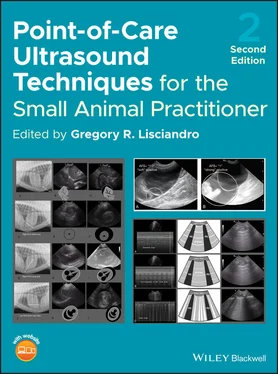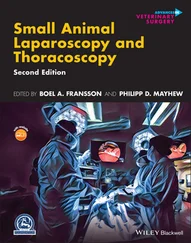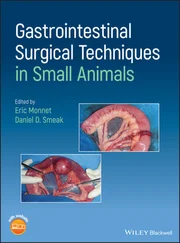6 Mohammadi A, Ghasemi‐Rad M. 2012. Evaluation of gastrointestinal injury in blunt abdominal trauma “FAST is not reliable”: the role of repeated ultrasonography. World J Emerg Surg 7(1):2.
7 Mongil CM, Drobatz KJ, Hendricks JC. 1995. Traumatic hemoperitoneum in 28 cases: a retrospective review. J Am Anim Hosp Assoc 31:217–222.
8 Muir W. 2006. Trauma: physiology, pathophysiology, and clinical implications. J Vet Emerg Crit Care 16(4):253–263.
9 Pintar J, Breitschwerdt EB, Hardie EM, et al. 2003. Acute nontraumatic hemoabdomen in the dog : a retrospective analysis of 39 cases (1987–2001). J Am Anim Hosp Assoc 37:518–522.
10 Quantz JE, Miles MS, Reed AL, et al. 2009. Elevation of alanine transaminase and gallbladder wall abnormalities as biomarkers of anaphylaxis in canine hypersensitivity patients. J Vet Emerg Crit Care 19(6):536–544.
11 Rozycki GS. 1998. Surgeon performed US: its use in clinical practice. Ann Surg 228:16–28.
12 Rozycki GS, Pennington SD, Feliciano DV. 2001. Surgeon‐performed ultrasound in the critical care setting: its use as an extension of the physical examination to detect pleural effusion. J Trauma 50(4):636–642.
13 Sgourakis G, Lanitis S, Zacharioudakis C, et al. 2012. Incidental findings in trauma patients during focused assessment with sonography for trauma. Am Surg 78(3):366–372.
Chapter Seven POCUS: AFAST – Clinical Integration
Gregory R. Lisciandro
The AFAST, having exact clarity to its five acoustic windows, is a standardized, rapid screening test of the abdominal cavity, retroperitoneal space, and pleural cavity, including the pericardial sac, heart, and lung. Even for the novice sonographer, the AFAST examination likely will take no more than 3½–4 minutes. In the previous AFAST chapter, we covered image acquisition and the AFAST target organ approach, examples of typical negative and positive images, pitfalls, and artifacts.
In this AFAST chapter, we will discuss clinical integration of AFAST findings as well as its limitations. Enjoy this wild AFAST ride of patient information that gives evidence‐based information by “seeing” your patient's problem list for a better working diagnosis, a better way to manage bleeding patients, a better way to track effusions, a better diagnostic plan for picking the next best test, and much more.
We will cover the following ( Table 7.1).
The abdominal fluid scoring system in different subsets of bleeding patients including blunt trauma, penetrating trauma, postinterventional, and nontrauma.
The use of the diaphragmatico‐hepatic (DH) view for pericardial and pleural effusion.
The use of the DH view for lung pathology along the pulmonary‐diaphragmatic interface.
The use of the DH view and the caudal vena cava for volume status.
The detection and interpretation of gallbladder wall edema, the so‐called “gallbladder halo sign,” that is a marker for canine anaphylaxis as well as cardiac conditions in the acute collapse, triaged setting.
Target organ conditions at respective AFAST views that may be easily recognized as “abnormal” to capture cases otherwise missed without ultrasound.
What AFAST Clinical Integration Can Do
Can detect free fluid within the abdomen, retroperitoneal space, pleural cavity, pericardial sac superior to physical examination and abdominal radiography and comparable to the gold standard of computed tomography (CT).
Can semiquantitate intraabdominal hemorrhagic and nonhemorrhagic effusions using its AFAST‐applied abdominal fluid scoring system.
Can anticipate degree of anemia in hemorrhaging dogs and cats by using its abdominal fluid scoring system and the small volume versus large volume principle.
Can help with decision making for blood transfusion and surgical interventions in hemorrhaging dogs and cats including blunt trauma, penetrating trauma, postinterventional (percutaneous biopsy, laparoscopy, and postlaparotomy, i.e., ovariohysterectomy, splenectomy, adrenalectomy, liver lobectomy, nephrectomy, gastrointestinal surgery, bladder surgery, etc.) by applying its abdominal fluid scoring system.
Can be used serially (repeating AFAST) for surveillance of all patients atrisk for bleeding, peritonitis, and other nonhemorrhagic effusive conditions. Table 7.1. Questions answered during AFAST.Source: Reproduced with permission of Dr Gregory Lisciandro, Hill Country Veterinary Specialists and FASTVet.com, Spicewood, TX.Is there any free fluid in the abdominal (peritoneal) cavity?Yes or noHow much free fluid is in the abdominal cavity using the AFAST‐applied fluid scoring system?0 (negative), 1, 2, 3, and 4 (maximum score)Is there any pericardial effusion?Subjective amount?Yes or noTrivial (<0.5 cm), mild (>0.5 and <1.0 cm), moderate (>1.0 and <2 cm), severe (>2 cm) on DH view (Candotti and Arntfield 2015)Is there any pleural effusion?Subjective amount?Yes or noTrivial, mild, moderate, severeWhat does the pulmonary‐diaphragmatic surface look like?Are there any lung lesions along the diaphragm?Unremarkable or abnormalB‐lines, shred sign, tissue sign, nodule sign (Lisciandro 2014c; Lisciandro and Fosgate 2017)What does the gallbladder look like?Unremarkable, halo sign, abnormalities in its lumen or wallWhat do the target organs look like at each AFAST view?Unremarkable or abnormalWhat do the caudal vena cava and its associated hepatic veins look like?Unremarkable (bounce) or abnormal (FAT, flat) (see Tables 7.6and 36.3 and Figures 36.7, 36.10–36.12) and presence of “tree trunk sign” (see Figure 36.8)What is estimated bladder volume?What is estimated urine output?Length (cm) × width (cm) × height (cm) × 0.625 = estimation in milliliters (mL)Difference in serial volume measurements/time (Lisciandro and Fosgate 2017)Could I be misinterpreting an artifact or pitfall as pathology?Know pitfalls and artifacts (see Chapter 6)
Can serially track bleeding patients as worsening (ongoing) hemorrhage (increasing AFS), static hemorrhage (no change in AFS), and resolution (decreasing AFS).
Can serially track peritonitis (and other nonhemorrhagic effusions) as worsening (increasing AFS), static (no change in AFS), and resolution (decreasing AFS).
Can detect retroperitoneal effusion when imaging at the AFAST spleno‐renal (SR) and hepato‐renal (HR) views.
Can detect pleural and pericardial effusions by routinely imaging cranial to the diaphragm at the AFAST DH view.
Can screen for anaphylaxis in dogs through the detection of sonographic striation of the gallbladder wall, referred to as the “halo effect,” “double rim effect” or “gallbladder halo sign” at the AFAST DH view; however, the finding is not pathognomonic and cardiac conditions should always be ruled out in the acute triage setting and other more chronic causes.
Can assess volume status and right‐sided cardiac function by evaluating caudal vena caval size and characterization coupled with hepatic venous distension and gallbladder wall edema at the AFAST DH view.
Can screen for obvious target organ injury or pathology, serving as a soft tissue screening test.
Can assess urinary bladder integrity (rupture or intact) at the AFAST cysto‐colic (CC) view in trauma and urinary obstructed cases.
Can noninvasively estimate urinary bladder volume and thus urine output through bladder measurements at the AFAST CC view.
What AFAST Clinical Integration Cannot Do
Cannot ultrasonographically characterize fluid, so sample acquisition via centesis and fluid analysis and cytology is required when free fluid is safely accessible.
Lacks sensitivity for injury in penetrating trauma because blood acutely clots, but is likely highly specific for intraabdominal and retroperitoneal injury similar to human studies; serial examinations are imperative in questionable patients.
Читать дальше












